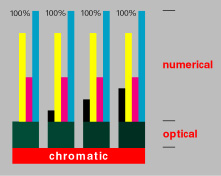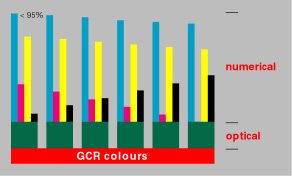.
PSO,
CtP, L*/a*/b*, Delta-E, plusminus, ISO ... |
|
. |
 |
.
The secret of unambiguous colour definition
Not to
recognize immediately but nonetheless of most importance
at the VierFarbSelector is its typical representation of optical
colour solitaires.
.
|
|
|
|
 |
|
|
|
.
|
|
At the
VierFarbSelector
colour tones are only built up with Black, if at least one
of the 3 basic colours Cyan, Magenta and Yellow is saturated and has therefore the
percentage of 100%. In the above example it is Cyan.
That means: Changing
the value of the black part of a colour tone will optically
result in another colour tone
.
. .........
.
.
.
.
.
.
.
.
..
. |
... |
.
At a
GCR
colour chart,
where one black screen after another is laid over all
colours per page in total, a multitude of optical colour
duplicates will be created, which are only different by
their numerical composition of C, M, Y and K.
.
That means: Changing the value of the black part of a
colour tone may optically result in another colour tone - or in
the same.
But how to
control the impression of a colour at prepress or later,
if the scanner operator has chosen another "GCR value"
as the graphic artist?
.
..............
.
|
Additional: The mixture of chromatic and achromatic
values for colour tones is leading to
a
serious deviation from the latest Media Standard,
which is fixing the CMYK composition under 50% GCR.
This "GCR value" can already be reached
with 10% Black at Pastel colours, or with 60% Black
at dark colour tones - but who knows the resulting
colour BEFORE scanning? |
|
|
 |
.
Highly precise colour
definition
of the VierFarbSelector
through representation of the CMYK colour tones on the official paper
grades for offset printing according the latest Media Standard from bvdm
(Confederation for Printing and Media in Germany), according the guidelines for the PSO- certification (Process
Standard Offset) as well as the standard for
newsprint according ISO 12647-3 with 26% dot gain in the area of
40/50%, which is valid since July 2005 worldwide.
. |
|
.
The
production
of the new VierFarbSelector
colour charts was done by using the
Computer-to-Plate process
(positive copy) with printing machines of the latest
generation and with ultramodern measurement technique and control
engineering. This technique resulted in an unusual exact constancy of
the colour values over the sheet width and the edition.
.
.
.
.
.
.
.
. |
|
.
The spectrum metric tolerance
for the solid tones
of CMYK according
L*/a*/b* - colour coordinates could (e.g. at paper grade
1 and 2, which are used mostly), be kept under Delta-E = 2,35 (allowed Delta-E = 5).
The dot gain tolerance for the halftones could be kept at plusminus
1% at 13% in the 40%-area (allowed plusminus 4%).
Likewise the grey balance was checked carefully and
permanently by using the media control bar for the optically same
impression of the basic colours CMY versus Black.
. |
|
|
|
|
|
|
|
|
|
|
|
|
|
|
|
| . |
|
|
|
|
|
. |
|
|
It
has been printed:
.
A)
Offset printing according ISO 12647-2:
.
Paper grade 1: Illustration paper woodfree, glossy
coated, 70g/qm
plus
Paper grade 2: Illustration paper woodfree, (silk)matt coated, 70g/qm
plus
Paper grade 3: LWC paper woodpulp, machine coated,
approx. 65g/qm
Paper grade 4: Offset paper woodfree, uncoated white
Paper grade 5: Offset paper woodfree, uncoated yellowish (ivory) |
.
VierFarbSelector: 250g/qm
VierFarbSelector: 250g/qm
VierFarbSelector: 070g/qm
VierFarbSelector: 250g/qm
VierFarbSelector: 250g/qm |
For
instance, according to the latest Media Standard, the
screen for paper grade 1 and 2 may be between 150 lines
and 200 lines per inch,
but - different from the past - the dot gains have to
be the same for all those screens and to be adjusted by
the Computer-to-Plate process (CtP)! For the VierFarbSelector
150 lines per inch were chosen,
an additional printing version with 200 lines per inch
was consequently left out; as well as further papers for web
offset, as only LWC paper is standardized and the
VierFarbSelector is only representing Standards.
The so called printing ink
'Europescale'
- colloquially also described as 'Euroscale' - has
become obsolete
or
is dissolved within the Standard ISO 12647. Therefore
the printing ink is only called 'ISO 2846-1' for Offset
and 'ISO
2846-2 Coldset' for newsprint. But in daily business it
will be talked about as Euroscale furthermore for some
time.
.
B)
Newspaper rotary printing according ISO 12647-3
.
Newsprint 54g/qm (10%
mechanical pulp, 90%
recycled pulp) with ISO 2846-2 Coldset, 100 lines per
inch.
Notice: Colour charts on newsprint, e.g. with 60 L/cm or
not with standardized ink ISO 2846-2 Coldset do not
represent the latest Media Standard.
.
|
|
|
|
|
|
|
|



